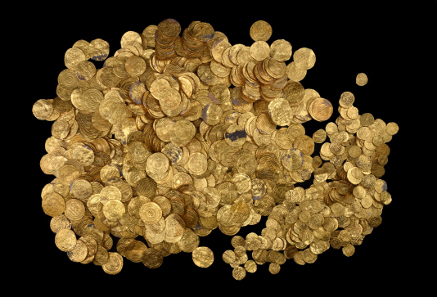March 5, 2015 – In February it became known that the largest treasure of gold coins discovered in Israel was found on the seabed in the ancient harbour in the Caesarea National Park. A group of divers from the diving club in the harbour found the lost treasure. According to them, at first they thought they had spotted a toy coin from a game and it was only after they understood the coin was ‘the real thing’ that they collected several coins and quickly returned to the shore in order to inform the director of the dive club about their find who in turn reported the discovery to the Marine Archaeology Unit of the Israel Antiquities Authority.
After quickly organizing, divers of the Israel Antiquities Authority went together with the group of divers out to where the coins were found and using a metal detector discovered almost 2,000 gold coins in different denominations: a dinar, half dinar and quarter dinar, of various dimensions and weight.
The Fatimid coin hoard. Photograph: Clara Amit. Courtesy of the Israel Antiquities Authority.
The earliest coin exposed in the treasure is a quarter dinar minted in Palermo, Sicily in the second half of the ninth century CE. Most of the coins though belong to the Fatimid caliphs Al-Hakim (996-1021 CE) and his son Al-Zahir (1021-1036), and were minted in Egypt and North Africa. The coin assemblage included no coins from the Eastern Islamic dynasties and it can therefore be stated with certainty this is a Fatimid treasure.
The great value and significance of the treasure become apparent when viewed in light of the historical sources. For example, the description of the traveller and geographer Ibn Jubayr who writes that the Muslim residents of the settlements were required to pay the Fatimid government half their agricultural produce at harvest time, in addition to payment of a head tax of one dinar and five carats (twenty-four carats equal one dinar, hence the method used to measure gold according to carats).
According to Kobi Sharvit, director of the Marine Archaeology Unit of the Israel Antiquities Authority, this is fascinating and rare historical evidence of life in the past which was exposed during winter storms. ‘The discovery of such a large hoard of coins that had such tremendous economic power in antiquity raises several possibilities regarding its presence on the seabed. There is probably a shipwreck there of an official treasury boat which was on its way to the central government in Egypt with taxes that had been collected. Perhaps the treasure of coins was meant to pay the salaries of the Fatimid military garrison which was stationed in Caesarea and protected the city. Another theory is that the treasure was money belonging to a large merchant ship that traded with the coastal cities and the port on the Mediterranean Sea and sank there. In the Marine Archaeological Unit of the Israel Antiquities Authority they are hoping that with the salvage excavations that will be conducted there, it will be possible to supplement our understanding of the entire archaeological context, and thus answer the many questions that still remain unanswered about the treasure.’
According to Robert Kool, an expert numismatist with the Israel Antiquities Authority, ‘The coins are in an excellent state of preservation, and despite the fact they were at the bottom of the sea for about a thousand years, they did not require any cleaning or conservation intervention from the metallurgical laboratory. This is because gold is a noble metal and is not affected by air or water. The coins that were exposed also remained in the monetary circulation after the Crusader conquest, particularly in the port cities through which international commerce was conducted. Several of the coins that were found in the assemblage were bent and exhibit teeth and bite marks, evidence they were “physically” inspected by their owners or the merchants. Other coins bear signs of wear and abrasion from use while others seem as though they were just minted.’
As for the divers, according to Israel’s law they cannot expect any finders’ fee as the state claims all property on the treasure. So Kobi Sharvit expressed vividly his warm feelings about the four divers Tzvika Feuer, Kobi Tweena, Avivit Fishler, Yoav Lavi and Yoel Miller: ‘These divers are model citizens. They discovered the gold and have a heart of gold that loves the country and its history’ Sharvit added, ‘The Law of Antiquities states that all antiquities belong to the state and that not reporting or removing antiquities from their location, or selling or trading them is an offense punishable by up to five years imprisonment. In this case the divers reported the find; but in many instances divers take the objects home and that way extremely important archaeological information is lost forever, which cannot be recovered. Therefore the discovery of the treasure underscores the need to combine the development of the place as a tourism and diving site with restrictions that will allow the public to dive there only when accompanied by inspectors or instructors from the diving club.’
The Caesarea Development Company and Nature and Parks Authority welcomed the discovery of the treasure. According to them, ‘There is no doubt that the discovery of the impressive treasure highlights the uniqueness of Caesarea as an ancient port city with rich history and cultural heritage. After 2,000 years it is still capable of captivating its many visitors, of continuing to innovate and surprise again when other parts of its mysterious past are revealed in the ground and in the sea.’
The BBC reported on this hoard.
This is the official website of the Israel Antiquities Authority.





